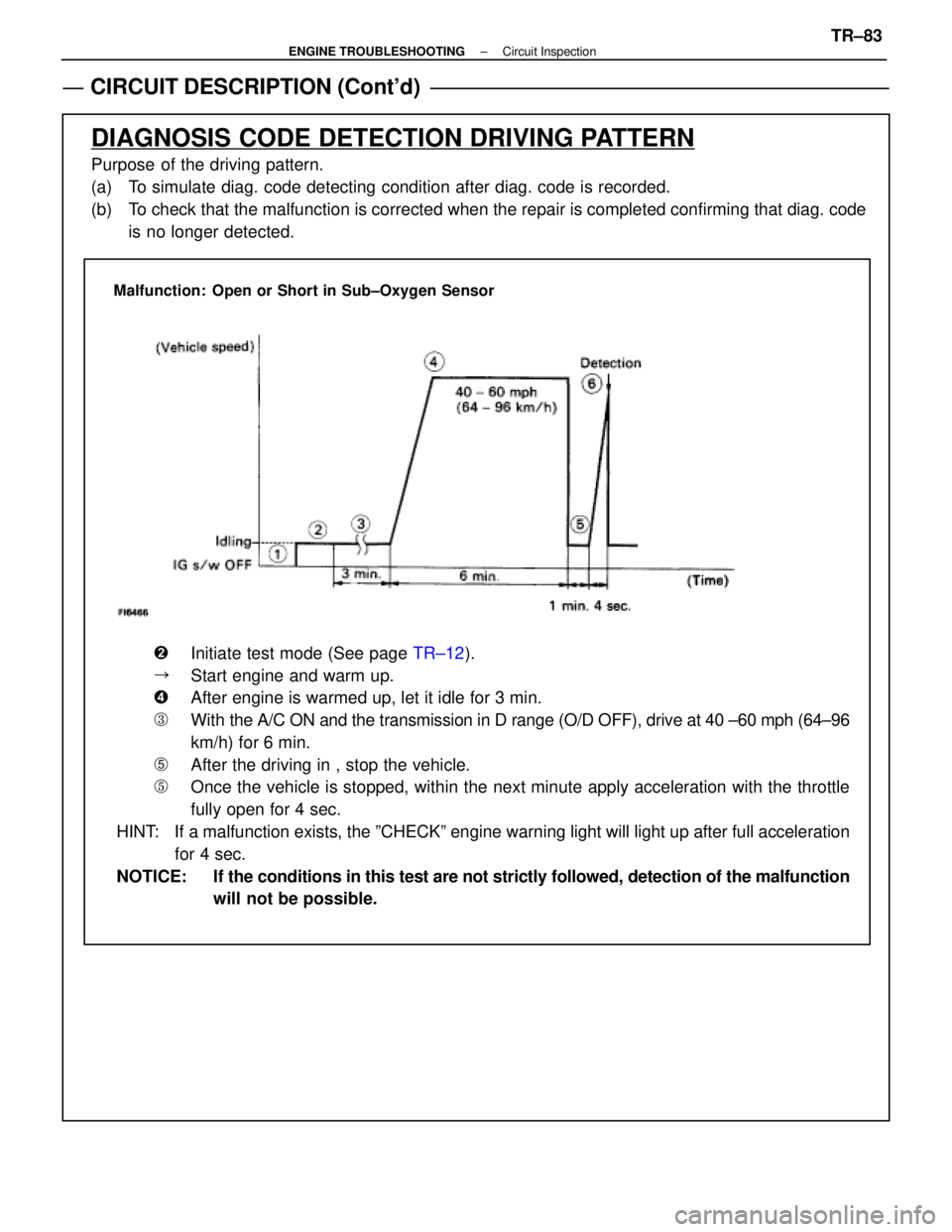Page 3496 of 4087

CIRCUIT DESCRIPTION (Cont'd)
DIAGNOSIS CODE DETECTION DRIVING PATTERN
Purpose of the driving pattern.
(a) To simulate diag. code detecting condition after diag. code is recorded.
(b) To check that the malfunction is corrected when the repair is completed co\
nfirming that diag. codeis no longer detected.
Malfunction: Open or Short in Sub±Oxygen Sensor
�Initiate test mode (See page TR±12).
�Start engine and warm up.
�After engine is warmed up, let it idle for 3 min.
�With the A/C ON and the transmission in D range (O/D OFF), drive at 40 ±\
60 mph (64±96
km/h) for 6 min.
�After the driving in , stop the vehicle.
�Once the vehicle is stopped, within the next minute apply acceleration w\
ith the throttle
fully open for 4 sec.
HINT: If a malfunction exists, the ºCHECKº engine warning light will light\
up after full acceleration for 4 sec.
NOTICE: If the conditions in this test are not strictly followed, detection of the\
malfunction will not be possible.
±
ENGINE TROUBLESHOOTING Circuit InspectionTR±83
WhereEverybodyKnowsYourName
Page 3497 of 4087
DIAGNOSTIC CHART
DIAGNOSTIC
CHART
HINT:
wWhen other codes are output in addition to 27 and 29 at the same time, check the ci\
rcuits for other
codes first.
w If diag. code 27 is displayed, check left bank sub±oxygen sensor circ\
uit, and if 29 is displayed,
check right bank sub±oxygen sensor circuit.
WIRING DIAGRAM
Check voltage of terminals HTL2, HTR2.
Check resistance of sub±oxygen sensor heater.
Check and repair sub±oxygen sensor heater
circuit.
Check operation of sub±oxygen sensor heater.
Check and replace ECU. Replace main oxygen sensor.
*: In this case, oxygen sensor can be deteriorated.
Replace main oxygen sensor.*
TR±84±
ENGINE TROUBLESHOOTING Circuit Inspection
WhereEverybodyKnowsYourName
Page 3498 of 4087
NGOK
OKNG
INSPECTION PROCEDURE
1Disconnect the engine & ECT ECU connector.
C
OK
P(2) Connect the Check Harness A.(See page TR±30)
(2) Disconnect engine & ECT ECU connector.
(2) Turn ignition switch on.
Measure voltage between terminals HTL2, HTR2 of en-
gine & ECT ECU connector and body ground.
Voltage: 10 ± 14 V
Go to step [3].
2Check sub±oxygen sensor heater.
C
OK
PDisconnect sub±oxygen sensor connector.
Measure resistance between terminals 1 and 2 of sub±
oxygen sensor connector.
Resistance: 5.1 ± 6.3 � 20 �C (68 �F)
Replace sub±oxygen sensor.
Check and repair harness or connector between
main relay and sub±oxygen sensor, sub±oxygen
sensor and engine & ECT ECU.
±
ENGINE TROUBLESHOOTING Circuit InspectionTR±85
WhereEverybodyKnowsYourName
Page 3499 of 4087
NGOK
3Check voltage between terminals HTL2, HTR2 of engine & ECT ECU connector and \
body
ground.
C
OK
Hint
P(2) Connect engine & ECT ECU connector.
(2) Warm up engine to normal operating temperature.
Measure voltage between terminals HTL2, HTR2 of en-
gine & ECT ECU connector and body ground, when en-
gine is idling and racing at 4,000 rpm.
In the 4,000 rpm racing check , continue engine racing
at 4,000 prm for approx. 20 seconds or more.
Replace sub±oxygen sensor.**: In this case, oxygen sensor can be deteriorated.
Check and replace engine & ECT ECU.
TR±86±
ENGINE TROUBLESHOOTING Circuit Inspection
WhereEverybodyKnowsYourName
Page 3503 of 4087
DIAGNOSTIC CHART
DIAGNOSTIC
CHART
WIRING DIAGRAM
Check and replace ECU.Replace air flow meter. Check and replace ECU.
Check voltage of air flow meter power source. Check voltage terminal KS of ECU.
Check for open and short in harness and
connector between air flow meter and ECU. Check voltage of terminal KS.
Repair or repolace harness or
connector
When diag. code 31 is displayed,
check and replace ECU.
±
ENGINE TROUBLESHOOTING Circuit InspectionTR±89
WhereEverybodyKnowsYourName
Page 3504 of 4087
NGOK
OKNG
INSPECTION PROCEDURE
1Check voltage between terminals KS and E1 of engine & ECT ECU connector.
C
OK
PConnect the check harness A.
(See page TR±30)
Measure voltage between terminals KS and E1 of en-
gine & ECT ECU connector while engine is cranked.
Voltage: 2.0 ± 4.0 V (Neither 0 V nor 5 V)
When diag. code 31 is displayed, check and replace en-
gine & ECT ECU.
2Check for open and short in harness and connector between engine & ECT ECU and air flow
meter (See page IN±27).
Repair or replace harness or connector.
TR±90
±
ENGINE TROUBLESHOOTING Circuit Inspection
WhereEverybodyKnowsYourName
Page 3505 of 4087
OKNG
NGOK
3Disconnect air flow meter connector and check voltage between terminals \
KS and E1 of engine
& ECT ECU.
C
OK
PDiconnect the air flow meter connector.
Turn ignition switch on.
Measure voltage between terminals KS and E1 of en-
gine & ECT ECU.
Voltage: 4 ± 6 V
Check and replace ECU.
4Diconnect air flow meter connector and check voltage between terminals VC and E1 \
of engine
& ECT ECU.
C
OK
PDiconnect the air flow meter connector.
Turn ignition switch on.
Measure voltage between terminals VC and E1 of en-
gine & ECT ECU.
Voltage: 4 ± 6 V
Replace air flow meter.
Check and replace engine & ECT ECU.
±
ENGINE TROUBLESHOOTING Circuit InspectionTR±91
WhereEverybodyKnowsYourName
Page 3509 of 4087
DIAGNOSTIC CHART
DIAGNOSTIC
CHART
HINT:
wIf diag. code 41 is displayed, check throttle position sensor circuit; if d\
iag. code 47 is displayed,
check sub±throttle position sensor circuit.
w If diag. codes º22º (water temperature sensor circuit), º24º\
(intake air temperature sensor circuit)
and º41º (throttle position sensor circuit) are output simultaneous\
ly, E2 (sensor ground) may be
open.
WIRING DIAGRAM
Check and replace ECU. Adjust or replace throttle position
sensor.
Check for momentary interruption
(See page
TR±23).
Repair or replace harness or
connector.
Check voltage of throttle position sensor.
Check operation for throttle position sensor.
Check for open and short in harness and
connector between throttle position sensor and ECU.
±
ENGINE TROUBLESHOOTING Circuit InspectionTR±95
WhereEverybodyKnowsYourName